Jason Schneider
the Camera Collector
The Rise & Fall of Dresden, Europe’s Greatest Camera Making City, Part 1, the pre-WW II era
For over 100 years its myriad factories turned out innovative designs that inspired the world and helped propel Photography forward.
By Jason Schneider
Dresden, the venerable capital city of Saxony in eastern Germany, also was the capital of German photo-related industries going back to the 19[SUP]th[/SUP] century. Starting in 1865, photographic paper makers began building factories in Dresden, and from about 1887 the city became Europe’s leading photographic manufacturing center, which it remained, despite the vicissitudes of war, politics, and economics, until roughly 1990.
According to Wikipedia the earliest camera makers in Dresden were:
Richard Hüttig (moved from Berlin to Dresden in 1887)
Wilhelm Franz Matthias (starting in 1889, Ernemann & Matthias)
Emil Wünsche (made cameras beginning in 1889)
Unger & Hoffmann (paper maker, started making cameras in 1890)
Paul Förster (started production of cameras in 1893)
Ferdinand Franz Meyer, (made lenses from 1894, cameras from 1897)
Goltz & Breutmann, (maker of Mentor cameras; launched in 1899)
Scores of additional optical/mechanical companies were subsequently founded, some of which later merged, and until WWII many influential camera designs and concepts later used by other makers had been first introduced by Dresden's flourishing camera industry.
A watershed event in the photographic saga of Dresden was The Great Zeiss-Ikon Merger if 1926. By that time the economy of Germany was in tatters, with hyperinflation exacerbated by an insupportably rapid repayment schedule for the reparations incurred for the defeated nation’s role in WWI. The sausage factories were on strike, the beer was being watered down, and people were literally dying in the streets. To save their manufacturing base, the four largest German camera manufacturers, Ernemann, Ica, Goerz, and Contessa-Nettel, merged to form Zeiss-Ikon, under the financial aegis of Carl Zeiss, the largest and most diverse optical manufacturing company in Europe. This cemented the role of Dresden as the largest camera manufacturing region on the continent. Watered down beer meant things were desperate.
14 Leading Camera makers with factories in Dresden prior to WW II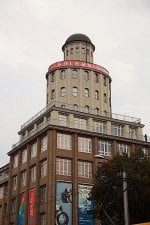
The Ernemann Tower built in 1924 on the outskirts of Dresden was the first (12-story) high-rise building in the area. Taken over by VEB Pentacon after WWII it became (in the form of a line drawing) the Pentacon logo inscribed on cameras etc. to impart some historic luster to the company's Dresden-made products.
Iconic Dresden products of the pre-WW II era
The Ermanox: In 1924, Ernemann-Werke AG of Dresden, then an independent company, unleashed the Ermanox, essentially a “miniature” solid metal bodied, leather clad, iteration of their classic folding, focal-plane shutter press cameras, that took pictures on individual 4.5 x 6 cm glass plates and had a giant 10cm f/2 Ernostar lens in a massive unit-focusing helical permanently affixed to its front. The new model created a sensation, and was soon adopted by pioneer photojournalist Dr. Erich Salomon, acclaimed for his uncanny ability to capture surreptitious indoor pictures of the famous and infamous. Almost singlehandedly Salomon transformed the Ermonox from a fascinating (and expensive!) curiosity into the cult camera of emerging photojournalists and photo enthusiasts of the day.
Alas, by 1931 the ingenious Ermanox, by then sold under Zeiss-Ikon banner, had ceased production, vanquished by the all-conquering Leica, which was smaller, far better integrated, and infinitely more convenient to shoot with. By the time Leitz came out with the model II (or D), the first Leica with a built-in coupled rangefinder, in 1932, and released the 50mm f/2 Summar lens shortly thereafter, the audacious Ermanox was already a dead letter. Indeed, even longtime Ermanox devotee Erich Salomon had abandoned it, switching to the Leica.
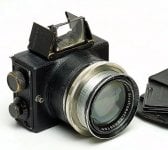
Ernemann's Ermanox of1924, had a "super-speed"100mm f/2 Ernostar lens, It was the photojournalists' favorite until ousted by the much handier Leica.
Ernostar and Sonnar lenses: Breakthrough designs by Ludwig Bertele
The groundbreaking lens on the original Ermanox was designed by Ludwig Bertele, one of the foremost lens designers of the 20[SUP]th[/SUP] century, His 100mm f/2 Ernostar of 1923, equivalent to a 58mm in the full frame 35mm format, is an asymmetrical design, a highly evolved derivative of the Cooke triplet with an extra positive front group. In 1924, Bertele designed two improved, slightly faster versions, the 85mm f/1.8 Ernostar and 105mm f/1.8 Ernostar which were used on later rigid and strut type collapsible versions of the 4.5 x 6 cm Ermanox and on the Ermanox Reflex, a 4.5 x 6 cm waist-level viewing SLR based on the same basic design. There was also a 6.5 x 9cm strut-type folding Ermanox with a bellows and a huge 12.5 cm f/1.8 Ernostar lens, and 9 x 12 cm Ermanoxes in both Tropical (teak wood) and standard versions, each of which sported a humongous 16.5 cm f/1.8 Ernostar lens. These are all gorgeous, eminently collectible, and stratospherically priced, but they’re also grand dinosaurs of the pre-Leica/Contax era.
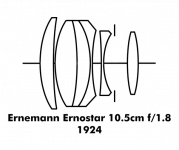
The 6-element, 4 group 10.5cm f/1.8 Ernostar by Ludwig Bertele was an improvement on the earlier f/2 version. Note signature cemented triplet in group 2.
The Sonnar lens: Named for the sun, with more light-gathering power
Bertele was also responsible for creating the acclaimed high-speed 50mm f/1.5 and 50mm f/2 Zeiss Sonnar lenses for the Zeiss Contax I, which debuted of 1932. The first production Zeiss Sonnar was a 50 mm f/2 lens with six elements in three groups. In 1931, it was reformulated with seven elements in three groups allowing what was then a super-speed maximum aperture of f/1.5. Compared to Planar designs the Sonnars had more aberrations, but with fewer glass-to-air surfaces they had better contrast and less flare, great advantages in the days prior to lens coating. Compared to the earlier Tessar design, the Sonnars’ faster aperture and lower level of chromatic aberrations was also a significant improvement. It is a tribute to the excellence of their original design that both the 50mm f/1.5 and f/2 Sonnar lenses, coated in postwar versions, were used on the Contax IIa and IIIa until 1961 when the line was discontinued.
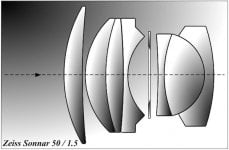
Bertele's brilliant 7-element, 3-group 50mm f/1.5 Sonnar of 1931 was made in coated versions for Contax 35s until 1961. Note cemented triplet in group 2
The Goerz Hypergon: It really took off, with or without a “propeller”!
Goerz pioneered Super Wide Large Format photography with their Hypergons, very short focal length lenses with phenomenal covering power (even by today's standards) of either 135 or 110 degrees. Production dates roughly from around 1910 to the late 1920s. That means that Hypergons were uncoated and today they’re quite rare and sought after both by collectors and photographers. They were made in a variety of focal lengths. Contrary to some opinions, they were made in versions with and without their famous rotating "star" in front of the lens to equalize exposure in the corners. Also, contrary to some reports, they were not designed for aerial photography.
For many years the Hypergon held a unique place among wide-angle lenses due to its incomparable covering power. It’s a symmetrical, double anastigmat design, consisting of two very thin hemispherical single glasses. Astigmatism, spherical aberration, and curvature of field are completely corrected, and the image is sharp to the very edges of the plate. Chromatic aberrations are not corrected but can be eliminated after focusing by stopping down to about f/31. The symmetrical design of the Hypergon ensures complete freedom from linear distortion, and the diminution of light toward the margins of the image, unavoidable in a lens covering such an extraordinary angle, is corrected by an ingenious device in the form a star diaphragm. This is a small star-shaped “propeller” which is rotated in front of the lens by means of a bulb and tube attachment, during the exposure, in effect a rubber air bulb that uses the air to spin the star!
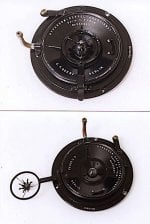
Goerz Hypergon Ultra-Wide-Angle was often fitted with a "star" propeller (see detail in bottom photo) that rotated using air pressure to even out the exposure.
The Hypergon is a special lens for wide-angle interiors, landscape, architectural and panoramic pictures, and it should not be purchased with the idea that it can be used for general photography. For one thing, it can’t be fitted to the between-the-lens leaf shutters typically used on large format cameras.
For over 100 years its myriad factories turned out innovative designs that inspired the world and helped propel Photography forward.
By Jason Schneider
Dresden, the venerable capital city of Saxony in eastern Germany, also was the capital of German photo-related industries going back to the 19[SUP]th[/SUP] century. Starting in 1865, photographic paper makers began building factories in Dresden, and from about 1887 the city became Europe’s leading photographic manufacturing center, which it remained, despite the vicissitudes of war, politics, and economics, until roughly 1990.
According to Wikipedia the earliest camera makers in Dresden were:
Richard Hüttig (moved from Berlin to Dresden in 1887)
Wilhelm Franz Matthias (starting in 1889, Ernemann & Matthias)
Emil Wünsche (made cameras beginning in 1889)
Unger & Hoffmann (paper maker, started making cameras in 1890)
Paul Förster (started production of cameras in 1893)
Ferdinand Franz Meyer, (made lenses from 1894, cameras from 1897)
Goltz & Breutmann, (maker of Mentor cameras; launched in 1899)
Scores of additional optical/mechanical companies were subsequently founded, some of which later merged, and until WWII many influential camera designs and concepts later used by other makers had been first introduced by Dresden's flourishing camera industry.
A watershed event in the photographic saga of Dresden was The Great Zeiss-Ikon Merger if 1926. By that time the economy of Germany was in tatters, with hyperinflation exacerbated by an insupportably rapid repayment schedule for the reparations incurred for the defeated nation’s role in WWI. The sausage factories were on strike, the beer was being watered down, and people were literally dying in the streets. To save their manufacturing base, the four largest German camera manufacturers, Ernemann, Ica, Goerz, and Contessa-Nettel, merged to form Zeiss-Ikon, under the financial aegis of Carl Zeiss, the largest and most diverse optical manufacturing company in Europe. This cemented the role of Dresden as the largest camera manufacturing region on the continent. Watered down beer meant things were desperate.
14 Leading Camera makers with factories in Dresden prior to WW II
- Altissa cameras
- Balda-Werk
- Certo
- Emil Wünsche
- Ernemann
- Filmosto (optical company)
- Hüttig
- Ihagee (Exakta)
- 9. International Camera Actiengesellschaft (Ica)
- Kamera-Werkstätten (KW
- Mimosa
- Pentacon
- Welta
- Zeiss-Ikon

The Ernemann Tower built in 1924 on the outskirts of Dresden was the first (12-story) high-rise building in the area. Taken over by VEB Pentacon after WWII it became (in the form of a line drawing) the Pentacon logo inscribed on cameras etc. to impart some historic luster to the company's Dresden-made products.
Iconic Dresden products of the pre-WW II era
The Ermanox: In 1924, Ernemann-Werke AG of Dresden, then an independent company, unleashed the Ermanox, essentially a “miniature” solid metal bodied, leather clad, iteration of their classic folding, focal-plane shutter press cameras, that took pictures on individual 4.5 x 6 cm glass plates and had a giant 10cm f/2 Ernostar lens in a massive unit-focusing helical permanently affixed to its front. The new model created a sensation, and was soon adopted by pioneer photojournalist Dr. Erich Salomon, acclaimed for his uncanny ability to capture surreptitious indoor pictures of the famous and infamous. Almost singlehandedly Salomon transformed the Ermonox from a fascinating (and expensive!) curiosity into the cult camera of emerging photojournalists and photo enthusiasts of the day.
Alas, by 1931 the ingenious Ermanox, by then sold under Zeiss-Ikon banner, had ceased production, vanquished by the all-conquering Leica, which was smaller, far better integrated, and infinitely more convenient to shoot with. By the time Leitz came out with the model II (or D), the first Leica with a built-in coupled rangefinder, in 1932, and released the 50mm f/2 Summar lens shortly thereafter, the audacious Ermanox was already a dead letter. Indeed, even longtime Ermanox devotee Erich Salomon had abandoned it, switching to the Leica.

Ernemann's Ermanox of1924, had a "super-speed"100mm f/2 Ernostar lens, It was the photojournalists' favorite until ousted by the much handier Leica.
Ernostar and Sonnar lenses: Breakthrough designs by Ludwig Bertele
The groundbreaking lens on the original Ermanox was designed by Ludwig Bertele, one of the foremost lens designers of the 20[SUP]th[/SUP] century, His 100mm f/2 Ernostar of 1923, equivalent to a 58mm in the full frame 35mm format, is an asymmetrical design, a highly evolved derivative of the Cooke triplet with an extra positive front group. In 1924, Bertele designed two improved, slightly faster versions, the 85mm f/1.8 Ernostar and 105mm f/1.8 Ernostar which were used on later rigid and strut type collapsible versions of the 4.5 x 6 cm Ermanox and on the Ermanox Reflex, a 4.5 x 6 cm waist-level viewing SLR based on the same basic design. There was also a 6.5 x 9cm strut-type folding Ermanox with a bellows and a huge 12.5 cm f/1.8 Ernostar lens, and 9 x 12 cm Ermanoxes in both Tropical (teak wood) and standard versions, each of which sported a humongous 16.5 cm f/1.8 Ernostar lens. These are all gorgeous, eminently collectible, and stratospherically priced, but they’re also grand dinosaurs of the pre-Leica/Contax era.

The 6-element, 4 group 10.5cm f/1.8 Ernostar by Ludwig Bertele was an improvement on the earlier f/2 version. Note signature cemented triplet in group 2.
The Sonnar lens: Named for the sun, with more light-gathering power
Bertele was also responsible for creating the acclaimed high-speed 50mm f/1.5 and 50mm f/2 Zeiss Sonnar lenses for the Zeiss Contax I, which debuted of 1932. The first production Zeiss Sonnar was a 50 mm f/2 lens with six elements in three groups. In 1931, it was reformulated with seven elements in three groups allowing what was then a super-speed maximum aperture of f/1.5. Compared to Planar designs the Sonnars had more aberrations, but with fewer glass-to-air surfaces they had better contrast and less flare, great advantages in the days prior to lens coating. Compared to the earlier Tessar design, the Sonnars’ faster aperture and lower level of chromatic aberrations was also a significant improvement. It is a tribute to the excellence of their original design that both the 50mm f/1.5 and f/2 Sonnar lenses, coated in postwar versions, were used on the Contax IIa and IIIa until 1961 when the line was discontinued.

Bertele's brilliant 7-element, 3-group 50mm f/1.5 Sonnar of 1931 was made in coated versions for Contax 35s until 1961. Note cemented triplet in group 2
The Goerz Hypergon: It really took off, with or without a “propeller”!
Goerz pioneered Super Wide Large Format photography with their Hypergons, very short focal length lenses with phenomenal covering power (even by today's standards) of either 135 or 110 degrees. Production dates roughly from around 1910 to the late 1920s. That means that Hypergons were uncoated and today they’re quite rare and sought after both by collectors and photographers. They were made in a variety of focal lengths. Contrary to some opinions, they were made in versions with and without their famous rotating "star" in front of the lens to equalize exposure in the corners. Also, contrary to some reports, they were not designed for aerial photography.
For many years the Hypergon held a unique place among wide-angle lenses due to its incomparable covering power. It’s a symmetrical, double anastigmat design, consisting of two very thin hemispherical single glasses. Astigmatism, spherical aberration, and curvature of field are completely corrected, and the image is sharp to the very edges of the plate. Chromatic aberrations are not corrected but can be eliminated after focusing by stopping down to about f/31. The symmetrical design of the Hypergon ensures complete freedom from linear distortion, and the diminution of light toward the margins of the image, unavoidable in a lens covering such an extraordinary angle, is corrected by an ingenious device in the form a star diaphragm. This is a small star-shaped “propeller” which is rotated in front of the lens by means of a bulb and tube attachment, during the exposure, in effect a rubber air bulb that uses the air to spin the star!

Goerz Hypergon Ultra-Wide-Angle was often fitted with a "star" propeller (see detail in bottom photo) that rotated using air pressure to even out the exposure.
The Hypergon is a special lens for wide-angle interiors, landscape, architectural and panoramic pictures, and it should not be purchased with the idea that it can be used for general photography. For one thing, it can’t be fitted to the between-the-lens leaf shutters typically used on large format cameras.

